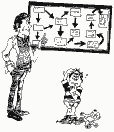
Here are the topics covered in the
Home Building Guide
as well as a Foreword by Ray Dunn.
 Each of the topical headings below link to an Adobe PDF file for that particular topic. Click here to get your free copy of Adobe Reader. Each of the topical headings below link to an Adobe PDF file for that particular topic. Click here to get your free copy of Adobe Reader.
The entire 200+ page "Home Building Guide" is contained within the following PDF files, and the topical headings below cover 19 important subject areas that are crucial to successful management of your project.
Click on the NEWEST VERSION of each topic to read the most current edition of the Home Building Guide. You can also view Tom's free Home Building Video, which is a 45-minute documentary produced as a complement to the Guide.
 The Decision Making Process is based on shared
responsibilities of a variety of construction professionals including architects,
trade contractors, suppliers, and building officials who contribute their expertise
to the residential Design/Build process. The Decision Making Process is based on shared
responsibilities of a variety of construction professionals including architects,
trade contractors, suppliers, and building officials who contribute their expertise
to the residential Design/Build process. Who will be the principal players
of your project team? We provide the "Decision Making Model" to better
visualize the key players and the information base from which they operate.
The format we use to arrange the complexity of information is a
residential Design/Build Matrix. We use this format to organize project details
so decisions can be made sensibly and sequentially for both architecture and construction.
How do you differentiate between design and build events? Let
our "Design/Build Matrix" be a map to guide you. We identify over 35 important
issues for creating a "Design/Build" Action Plan!
Building and Living Green requires a dedication to residential Design/Build practices
which promote personal health and environmental protection for both architecture
and home building methods. What are the economic advantages to this approach
to building construction? Here are helpful hints for creating an economically
feasible yet environment friendly site.
Your
Contract Documents are a combination of four sets of information: Drawings, Specifications,
Conditions, and Agreements. Each set of information references the other sets,
and together form the basis of a good working relationship with the Trade Contractors
and Suppliers. Each set of information references the other sets, and
together form the basis of a good working relationship with Architects, Trade
Contractors, Suppliers, and Building Officials. Have you created these
documents before construction begins? Review the 31 issues you'll want
to include in this documentation.
 Drawings provide dimensions and layout for your residential,
architectural design. Drawings depict a homestyle which will meet the needs of
your family's lifestyle. Drawings provide dimensions and layout for your residential,
architectural design. Drawings depict a homestyle which will meet the needs of
your family's lifestyle. Can you define how you want to live on a
day-by-day basis? Here are the 32 universal elements common to all architectural
Drawings.
Specifications are
the written instructions of how residential construction will be performed and
the type of materials to be used in your home. How will you describe what
products or methods will be used for your home building project? Read
20 pages of "Sample Specifications" in order to construct a typical residential
construction project. Program planning is central to the success
of your home building project.
Permits are a legal consent
for construction work to proceed according to approved drawings and specifications.
Inspections are a shared responsibility by the local building department, owner,
trade contractors, and often times your architect. What public agencies
have jurisdiction over your site? We identify the critical inspection
points to observe as construction work progresses, and give some useful hints
for conflict resolution in the Design/Build process.
A Budget Estimate is a preliminary appraisal of all Design and Build costs.
Is your budget based on both hard and soft costs? But, there's more...
we also show a breakdown of "Builder's Overhead and Profit" as well as "Architect/Designer's
Fee".
A Cost Analysis is a complete examination
of all costs based on bid proposals from architects, trade contractors, and suppliers.
Are you certain all products and services required for your project are
included in the analysis? The 60 categories we cover in the Cost Analysis
are very comprehensive.
What we need is a fiscal method
to record the specific conditions of agreement between buyer and seller. This
is what a purchase order system accomplishes. Are your conditions of agreement
accurately presented as terms of purchase? Here are 21 issues you'll need
to consider when making a purchase.
Each Trade
Contractor takes responsibility for products and services related to their craft.
How will you qualify contractors for your project? Review a list
of 30 items for qualifying trade contractors.
Suppliers
are in business to buy direct from manufacturers then distribute goods to trade
contractors and the general public. What are your criteria for supplier
selection? Here are procedures for purchase, delivery, inspection, and
payment of goods required for residential construction.
 You need to assign a fixed date and time for architecture
and construction activities. You need to assign a fixed date and time for architecture
and construction activities. Do you understand the difference between
your expectations and the way things really happen? Our "bar chart" model
helps you visualize project sequence and the flow of work activities.
Benefit from 37 key questions for creating a "Schedule" Action Plan!
Safety is protection from personal injury or loss of property. You are liable
for accidents and theft. Are you aware of hazardous conditions or actions
on your site? Here's a list of 38 items which cause 95% of all accidents.
Quality Control is the act of maintaining a high
degree of excellence whether it concerns a person's behavior or product installation.
How do you get in control of quality? Review 30 pages of checklists
from "Sitework" to "Trim Package".
A Punch List is
an inventory of those items which are incomplete or in need of repair.
Is it reasonable to expect a standard of zero defects? Learn 5 essential
"tricks of the trade" to control lengthy and bothersome Punch Lists. Another valuable resource for decision making are the numerous
architecture, trade, professional, and consumer associations who establish construction
standards and will provide product information. Who
are these associations and where can you contact them? Here's an alphabetical
listing of over 150 national trade, professional and consumer associations waiting
to be of assistance for your home building project.
Of the numerous books available, what are the "best of kind" for managing residential
architecture and construction? Are you an Active Learner? The Project Planner will help to set priorities. For the first-time
home builder, there's often a lack of sufficient planning. How will you
adapt the complexity of information to fit your situation? We tell you
how to take action and make decisions...
...During your design development;
...1 year prior to building permit application;
...As you create specifications
and request bid proposals;
...On submission of the building permit application;
...When the building permit is issued and during construction;
...When the
project is near completion;
...When you're ready for final inspection.
FOREWORD by Ray Dunn There is a great deal of satisfaction to
be gained from designing and building a home that addresses our needs and turns
 out as we visualize it. Tom Landis' "Consumer's Guide" is a collection of tools....
models, checklists, illustrations, and forms....which will assist you, the home
builder, to create and execute a workable plan to make the Design/Build process
an enriching experience. This "Guide" will help you to form your vision, to focus
on the details that are attainable within your budget and prepare you for the
inevitable challenges which will be presented during the design/build process.
out as we visualize it. Tom Landis' "Consumer's Guide" is a collection of tools....
models, checklists, illustrations, and forms....which will assist you, the home
builder, to create and execute a workable plan to make the Design/Build process
an enriching experience. This "Guide" will help you to form your vision, to focus
on the details that are attainable within your budget and prepare you for the
inevitable challenges which will be presented during the design/build process.
Each building project is a learning encounter for the seasoned Trade Contractor
as well as the Owner/Builder who may be undertaking a first construction experience.
Armed with the attitude that the architecture and construction process is an artistic
adventure of ideas, this "Guide" explains the process so you become a creative
participant who will direct the decision making process when your home building
project is in need of leadership and clarity of vision. Home building
is a collaborative, rational effort where the Owner/Builder can be in control
of the Design/Build process with a proper understanding of the dynamics which
will be faced during the project. While a portion of the actual building work
will be performed by professionals (Construction Manager, Architect, Trade Contractors,
Suppliers, Lawyer, Accountant), the Owner ultimately lives with the consequences
of all decisions. With an understanding of what to expect during the project,
the Owner/Builder is empowered to be a manager in problem solving situations,
and therefore must be prepared to take ownership of all quality control decisions.
As the employer of architectural and construction professionals, it is the responsibility
of the Owner to provide a consistent focus on quality throughout the entire design/build
process, but particularly at the beginning of the home building project when making
quality determinations is the most cost effective. Cost savings is an
obvious reason to be actively involved in the residential construction project,
but, as Tom points out, there are decision points where the Owner can choose either
to save money or spend additional money to upgrade the plan because of opportunity
or material availability. Working on a project plan that encompasses alternative
choices will reduce the number of anxiety producing situations. The "Consumer's
Guide" is not a book of answers, but a collection of pointers, drawn from years
of experience and a willingness to prepare you, the consumer, for these inevitable
decision points.  It is a pleasure for me to have the opportunity
to introduce this "Guide" because using it will help make the experience of building
a home a creative process for the reader who chooses to participate. As a former
home builder and now an educator, I am pleased to recommend this practical insight
to folks who would like to participate in the Design/Build process. It is a pleasure for me to have the opportunity
to introduce this "Guide" because using it will help make the experience of building
a home a creative process for the reader who chooses to participate. As a former
home builder and now an educator, I am pleased to recommend this practical insight
to folks who would like to participate in the Design/Build process. As
each of us likes to visualize our own dream home, only a few of us are lucky enough
to actually reach out and make that dream come true. To be successful we need
to communicate our vision to our community and the architecture and construction
professionals on the project team, but the experience reaches beyond this. The
building process creates a new community of companion roles working to achieve
our ideas; a community that will live on long after the last nail is driven.
| 

 The Decision Making Process is based on shared
responsibilities of a variety of construction professionals including architects,
trade contractors, suppliers, and building officials who contribute their expertise
to the residential Design/Build process.
The Decision Making Process is based on shared
responsibilities of a variety of construction professionals including architects,
trade contractors, suppliers, and building officials who contribute their expertise
to the residential Design/Build process.  Drawings provide dimensions and layout for your residential,
architectural design. Drawings depict a homestyle which will meet the needs of
your family's lifestyle.
Drawings provide dimensions and layout for your residential,
architectural design. Drawings depict a homestyle which will meet the needs of
your family's lifestyle. You need to assign a fixed date and time for architecture
and construction activities.
You need to assign a fixed date and time for architecture
and construction activities.  It is a pleasure for me to have the opportunity
to introduce this "Guide" because using it will help make the experience of building
a home a creative process for the reader who chooses to participate. As a former
home builder and now an educator, I am pleased to recommend this practical insight
to folks who would like to participate in the Design/Build process.
It is a pleasure for me to have the opportunity
to introduce this "Guide" because using it will help make the experience of building
a home a creative process for the reader who chooses to participate. As a former
home builder and now an educator, I am pleased to recommend this practical insight
to folks who would like to participate in the Design/Build process. 
